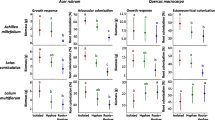Abstract
Arbuscular mycorrhizal fungal (AMF) symbiosis was thought to be rare in wetland plant roots, although several recent studies suggested that this association might be important in wetland ecosystems. In this research work we have studied the distribution of AMF in the marshy and shoreline vegetation of Deepar Beel Ramsar site of Assam, India. The study reveals the percentage of mycorrhizal colonization in the roots of different plant species which were observed from 20.89 to 86.47% and particularly found larger among the members of the family Poaceae. The Vetiveria zizanioides L. from the family Cyperaceae showed the highest (86.47%) percentage of root colonization, however, only one plant species viz. Scirpus lateriflorus Gmel. from the same family was found to be nonmycorrhizal. The rhizospheric soil samples of most of the plant species were found to be dominated by Glomus morphotypes. All total 18 AMF morphotypes were recorded which comprises four genera viz. Glomus (66.67%), Acaulospora (16.66%), Gigaspora (11.11%) and Scutellospora (5.56%). The observation of diversity of AMF in 25 different plant species among the wetland plants gives a glimpse of AMF diversity and their host selectivity in the said ecosystem.

Similar content being viewed by others
References
Bearden BN, Petersen L (2000) Influence of arbuscular mycorrhizal fungi on soil structure and aggregate stability of a vertisol. Plant Soil 218:173–183
Bever JD, Pringle A, Schultz PA (2002) Dynamics within the plant arbuscular mycorrhizal fungal mutualism: testing the nature of community feedback. In: van der Heijden MGA, Sanders IE (eds) Mycorrhizal ecology. Springer, Heidelberg, pp 267–292
Brundrett MC, Abbott LK, Jasper DA (1999) Glomalean mycorrhizal fungi from tropical Australia I. Comparison of the effectiveness and specificity of different isolation rocedures. Mycorrhiza 8:305–314
Cantelmo AJ Jr, Ehrenfeld JG (1999) Effects of microtopography on mycorrhizal infection in Atlantic white cedar (Chamaecy-paris thyoides (L.) Mills). Mycorrhiza 8:175–180
Clapp JP, Young JPW, Merryweather JW, Fitter AH (1995) Diversity of fungal symbionts in arbuscular mycorrhizae from natural community. New Phytol 87:259–265
Facelli E, Facelli JM (2002) Soil phosphorus heterogeneity and mycorrhizal symbiosis regulate plant intra-specific competition and size distribution. Oceologia 133:54–61
Gerdemann JW, Nicolson TH (1963) Spores of mycorrhizal endogone species extracted from soil by wet sieving and decanting. Trans Br Mycol Soc 46:235–244
Giovannetti M, Mosse B (1980) An evaluation of techniques for measuring vesicular-arbuscular mycorrhizal infection in roots. New Phytol 84:489–502
Gogoi R (2007) Conserving Deepar Beel Ramsar Site, Assam. Curr Sci 93(4):445–446
Keddy P (2000) Wetland ecology: principles and conservation. Cambridge University Press, New York
Koide RT, Mosse B (2004) A history of research on arbuscular mycorrhiza. Mycorrhiza 14:145–163
Li H, Smith SE, Holloway RE, Zhu Y, Smith FA (2006) Arbuscular mycorrhizal fungi contribute to phosphorous uptake by wheat grown in a phosphorous-fixing soil even in the absence of positive growth responses. New Phytol 172:536–543
Likar M, Bukovnik U, Kreft I, Chrungoo NK, Regvar M (2008) Mycorrhizal status and diversity of fungal endophytes in roots of common buckwheat (Fagopyrum esculentum) and tartary buckwheat (Fagopyrum tataricum). Mycorrhiza 18:309–315
Lingfei L, Anna Y, Zhiwei Z (2005) Seasonality of arbuscular mycorrhizal symbiosis and dark septate endophytes in a grassland site in southwest China. FEMS Microbiology Ecology 54:367–373
Lovera M, Cuenca G (1996) Arbuscular mycorrhizal infection in Cyperaceae and Gramineae from natural disturbed and restored savannas in La Gran Sabana, Venzuela. Mycorrhiza 6:111–118
Mohammad MJ, Pan WL, Kennedy AC (1998) Seasonal mycorrhizal colonization of winter wheat and its effect on wheat growth under dry land field conditions. Mycorrhiza 8:139–144
Muthukumar T, Udaiyan K (2002) Seasonality of vesicular arbuscular mycorrhizae in sedges in a semi-arid tropical grassland. Acta Oecologica 23:337–347
Myers N, Mittermeier RA, Mittermeier CG, Fonseca GAB, Kent J (2000) Biodiversity hotspots for conservation priorities. Nature 403:853–858
Oehl F, Sieverding E, Ineichen K, Ma¨ der P, Boller T, Wiemken A (2003) Impact of land use intensity on the species diversity of arbuscular mycorrhizal fungi in agroecosystems of Central Europe. Appl Environ Microbiol 69:2816–2824
Oehl F, Sieverding E, Ineichen K, Ris EA, Boller T, Wiemken A (2005) Community structure of arbuscular mycorrhizal fungi at different soil depths in extensively managed agroecosystems. New Phytol 165:273–283
Pivato B, Mazurier S, Lemanceau P, Siblot S, Berta G, Mougel C, van Tuinen D (2007) Medicago species affect the community composition of arbuscular mycorrhizal fungi associated with roots. New Phytol 176:197–210
Sanders IR (2002) Specificity in the arbuscular mycorrhizal symbiosis. In: van der Heijden MGA, Sanders IE (eds) Mycorrhizal ecology. Springer, Heidelberg, pp 415–437
Schenck NC, Perez Y (1990) Manual for identification of VAM fungi. INVAM, University of Florida, Gainesville, pp 1–283
Scott DA (1989) A dictionary of Asian Wetlands. IUCN, Gland, pp 452–453
Smith SE, Read DJ (1997) Mycorrhizal symbiosis, 2nd edn. Academic Press, San Diego
Van der Heijden MGA, Klironomos JN, Ursic M, Moutoglis P, Streitwolf-Engel R, Boller T, Wiemken A, Sanders IR (1998) Mycorrhizal fungal diversity determines plant biodiversity, ecosystem variability and productivity. Nature 396:69–72
Vandenkoornhuyse P, Ridgway KP, Watson IJ, Fitter AH, Young JPW (2003) Co-existing grass species have distinctive arbuscular mycorrhizal communities. Mol Ecol 12:3085–3095
Wang B, Qiu YL (2006) Phylogenetic distribution and evolution of mycorrhizas in land plants. Mycorrhiza 16:299–363
Wirsel SGR (2004) Homogenous stands of a wetland grass harbour diverse consortia of arbuscular mycorrhizal fungi. FEMS Microbiology Ecology 48:129–138
Wolfe BE, Weishampel PA, Klironomos JN (2006) Arbuscular mycorrhizal fungi and water table affect wetland plant community composition. J Ecol 94:905–914
Zhao ZW, Xia YM, Qin XZ, Li XW, Cheng LZ, Sha T, Wang GH (2001) Arbuscular mycorrhizal status of plants and the spore density of arbuscular mycorrhizal fungi in the tropical rainforest of Xishuangbanna, Southwest China. Mycorrhiza 11:159–162
Author information
Authors and Affiliations
Corresponding author
Rights and permissions
About this article
Cite this article
Choudhury, B., Kalita, M.C. & Azad, P. Distribution of arbuscular mycorrhizal fungi in marshy and shoreline vegetation of Deepar Beel Ramsar Site of Assam, India. World J Microbiol Biotechnol 26, 1965–1971 (2010). https://doi.org/10.1007/s11274-010-0377-8
Received:
Accepted:
Published:
Issue Date:
DOI: https://doi.org/10.1007/s11274-010-0377-8




